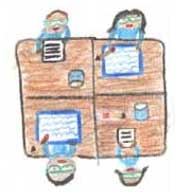Articles
 The resources listed are intended to provide a starting point for using drawings in science education research and for those who are interested in learning more about the findings from the Project Nexus teacher education project. For a more exhaustive list of sources please consult the reference lists of our individual publications.
The resources listed are intended to provide a starting point for using drawings in science education research and for those who are interested in learning more about the findings from the Project Nexus teacher education project. For a more exhaustive list of sources please consult the reference lists of our individual publications.
Hestness, E., Riedinger, K., & McGinnis, J. R, (in press, 2016). Approaches to using informal science education contexts to prepare informal and formal science educators In. P. Patrick, (Ed.), Preparing informal science educators, Springer Press, New York.
McGinnis, J. R., Hestness, E. (in press, 2016). Using drawings to make conjectures about teacher candidate’s moral reasoning about climate change. In P. Katz, (Ed.). Drawing conclusions: Drawings as data in science education. Sense Publishers, Netherlands.
Katz, P., McGinnis, J. R., Riedinger, K., Marbach-Ad, G. , Dai, A. (2013). The influence of informal science education experiences on the development of two beginning teachers’ classroom science teacher identity. Journal of Science Teacher Education, 23, 1357-1379. DOI 10.1007/s10972-012-9330-z).
McGinnis, J. R., Hestness, E., Riedinger, K., Katz, P., Marbach-Ad, G. & Dai, A. (2012). Informal science education in formal science teacher education. In K. Tobin, B.
Frasier, & C. McRobbie (Eds.), Second International Handbook of Science Education (pp.1097-1108). The Netherlands: Kluwer. DOI 10.1007/978-1-4020-9041-7.
Katz, P., McGinnis, J. R., Riedinger, K., Marbach-Ad, G. , Dai, A. (2012). The influence of informal science education experiences on the development of two beginning teachers’ classroom science teacher identity. Journal of Science Teacher Education, 23(8), online. DOI) 10.1007/s10972-012-9330-z).
McGinnis, J. R., Hestness, E., & Riedinger, K. (2011). Changing science teacher education in a changing global climate: Telling a new story. In Jing Ling and R. Oxford (Eds.), Transformative Eco-Education For Human Survival: Environmental Education In A New Era (pp. 117-133). Charlotte, North Carolina :Information Age Publishing.
Hestness, E. McGinnis, J. R., Riedinger, K., & Marbach-Ad, G. (2011). A study of teacher candidates’ experiences investigating global climate change education within an elementary science methods course. Journal of Science Teacher Education, 22, 351-369. DOI: 10.1007/s10972-011-9234-2
McGinnis, J. R., Hestness, E. (in press). Using Drawings to Examine Teacher Candidates’ Moral Reasoning About Climate Change. Boston: Sense Publishers.
Katz, P., McGinnis, J. R., Hestness, E., Riedinger, K., Marbach-Ad, G., Dai, A., et al. Professional Identity Development of Teacher Candidates Participating in an Informal Science Education Internship: A focus on drawings as evidence. International Journal of Science Education, 33(9), 1169-1197.
Katz, P., McGinnis, J. R., Riedinger, K., Dai, A., & Pease, R. (2011). Professional Identity Development of beginning Elementary Teachers of Science: A Comparative Case Study. An interactive poster presented at the annual meeting of the National Association for Research in Science Teaching (NARST), Orlando, FL, April 3 - 6, 2011.
Additional Resources (Non-Project Nexus Publications)
Carnes, N. (2009). Interpreting drawings of preservice teachers. In J. E. Pederson & K. D. Finson (Eds.), Visual Data. Rotterdam, 79-92.
Driver, R., Leach, J., Millar, R., & Scott, P. (1983). Young people's images of science. Philadelphia, PA: Open University Press.
Eick, C. J. (2009). Tailoring national standards to early science teacher identities: Building on personal histories to support beginning practice. Journal of Science Teacher Education, 20, 135-156.
Finson, K. D. (2001). Investigating preservice elementary teachers' self-efficacy relative to self image as a science teacher. Journal of Elementary Science Education, 13(1), 31-42.
Gee, J. P. (2001). Identity as an analytic lens for research in education. Review of Research in Education, 25, 99-125.
Luehmann, A. L. (2007). Identity development as a lens to science teacher preparation. Science Education, 91(5), 822-839.
Mead. M., & Metraux. R. (1957). The image of the scientist among high school students: A pilot study. Science, 126, 384-390.
National Research Council. (2007). Taking Science to School. Washington, D.C.: The National Academies Press.
National Research Council (2009). Learning Science in Informal Environments. Washington, D.C.: National Academies Press.
Schibeci, R.A. (1986). Images of science and scientists and science education. Science Education, 70,2, 139-149.
Sfard, A., & Prusak, A. (2005). Telling identities: In search of an analytic tool for investigating learning as a culturally shaped activity. Educational Researcher, 34(4), 14-22.
Symington, D. and Spurling, H. (1990). The draw-a-scientist test: Interpreting the data. Research in Science and Technological Education, 8, 75-77
Thomas, J. A., Pedersen, J.E., and Finson, K. (2001). Validating the Draw-A-Science-Teacher-Test Checklist (DASTT-C): Exploring Mental Models and Teacher Beliefs. Journal of Science Teacher Education, 12(3), 295-310.
Weber, S., & Mitchell, C. (1995). "That's Funny, You Don't Look Like A Teacher". Interrogating Images and Identity in Popular Culture. Philadelphia, PA: The Falmer Press, Taylor & Francis, Inc.
Visit our publications page for a complete list of Project Nexus publications and presentations.

